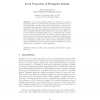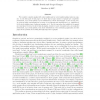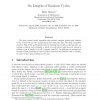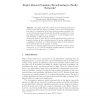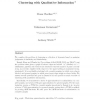124
click to vote
JCT
2010
14 years 11 months ago
2010
Let m1, m2, . . . , mt be a list of integers. It is shown that there exists an integer N such that for all n ≥ N, the complete graph of order n can be decomposed into edge-disjo...
102
click to vote
IPL
2007
15 years 13 days ago
2007
This paper presents a construction of a minimum cycle basis for the direct product of two complete graphs on three or more vertices. With the exception of two special cases, such ...
FUIN
2007
15 years 14 days ago
2007
In the paper triangular graphs are discussed. The class of triangular graphs is of special interest as unifying basic features of complete graphs with trees and being used on many ...
CORR
2007
Springer
15 years 15 days ago
2007
Springer
We consider complete graphs with edge weights and/or node weights taking values in some set. In the first part of this paper, we show that a large number of graphs are completely...
COMBINATORICS
2006
15 years 17 days ago
2006
We prove several results regarding edge-colored complete graphs and rainbow cycles, cycles with no color appearing on more than one edge. We settle a question posed by Ball, Pultr...
DM
2010
15 years 18 days ago
2010
In this paper we give a full characterization of the idomatic partitions of the direct product of three complete graphs. We also show how to use such a characterization in order t...
SIROCCO
2007
15 years 1 months ago
2007
This paper studies the problem of broadcasting in synchronous point-to-point networks, where one initiator owns a piece of information that has to be transmitted to all other verti...
103
click to vote
FOCS
2003
IEEE
15 years 5 months ago
2003
IEEE
We consider the problem of clustering a collection of elements based on pairwise judgments of similarity and dissimilarity. Bansal, Blum and Chawla (in: Proceedings of 43rd FOCS, ...

